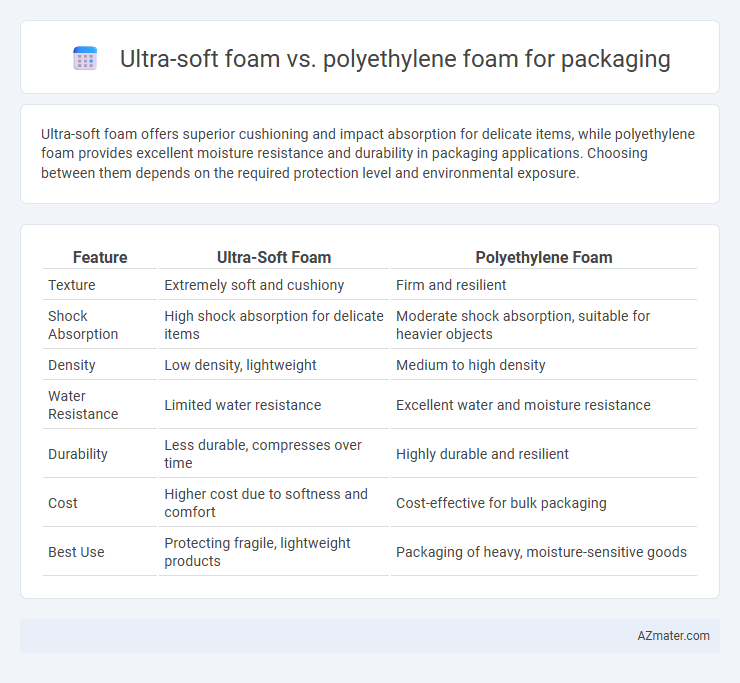Ultra-soft foam offers superior cushioning and impact absorption for delicate items, while polyethylene foam provides excellent moisture resistance and durability in packaging applications. Choosing between them depends on the required protection level and environmental exposure.
Table of Comparison
| Feature | Ultra-Soft Foam | Polyethylene Foam |
|---|---|---|
| Texture | Extremely soft and cushiony | Firm and resilient |
| Shock Absorption | High shock absorption for delicate items | Moderate shock absorption, suitable for heavier objects |
| Density | Low density, lightweight | Medium to high density |
| Water Resistance | Limited water resistance | Excellent water and moisture resistance |
| Durability | Less durable, compresses over time | Highly durable and resilient |
| Cost | Higher cost due to softness and comfort | Cost-effective for bulk packaging |
| Best Use | Protecting fragile, lightweight products | Packaging of heavy, moisture-sensitive goods |
Understanding Ultra-Soft Foam: Key Features
Ultra-soft foam offers exceptional cushioning properties due to its low density and high compressibility, making it ideal for delicate and fragile packaging applications. This foam type provides superior shock absorption and flexibility compared to polyethylene foam, which is denser and more rigid. Ultra-soft foam's breathable structure reduces moisture buildup, enhancing protection for sensitive electronics and medical devices during transit.
What is Polyethylene Foam?
Polyethylene foam is a versatile, closed-cell foam known for its excellent cushioning, shock absorption, and moisture resistance, making it ideal for protective packaging applications. Its lightweight yet durable structure provides superior impact protection compared to ultra-soft foam, which is softer but less resilient. Polyethylene foam's chemical stability and ability to withstand compressive forces extend the lifespan of packaged goods during transportation and storage.
Shock Absorption: Ultra-Soft Foam vs Polyethylene Foam
Ultra-soft foam provides superior shock absorption due to its low density and high cushioning properties, making it ideal for delicate and fragile items. Polyethylene foam offers excellent impact resistance with a closed-cell structure, which absorbs shocks effectively while providing moisture resistance. When comparing shock absorption, ultra-soft foam excels in cushioning fragile goods, whereas polyethylene foam balances durability and shock resistance for heavier or more robust products.
Cushioning Performance Comparison
Ultra-soft foam offers superior cushioning performance due to its low density and high compressibility, making it ideal for absorbing shocks and vibrations during packaging. Polyethylene foam provides excellent resilience and higher durability, maintaining its cushioning properties under repeated impacts and heavier loads. The choice between them depends on the specific packaging requirements, with ultra-soft foam excelling in delicate item protection and polyethylene foam preferred for robust, long-term cushioning solutions.
Durability and Longevity Analysis
Ultra-soft foam provides exceptional cushioning but tends to compress and degrade faster under repeated stress compared to dense polyethylene foam, which offers superior durability and resistance to wear. Polyethylene foam maintains its structural integrity over prolonged use, making it ideal for long-term packaging protection against impacts and environmental factors. Its closed-cell composition also prevents moisture absorption, enhancing longevity and preserving the packaging contents more effectively than ultra-soft foam.
Weight Differences and Shipping Impact
Ultra-soft foam typically weighs less than polyethylene foam, reducing overall package weight and lowering shipping costs. Polyethylene foam, while denser and heavier, offers greater impact resistance and durability for fragile items during transit. Choosing ultra-soft foam enhances efficiency in air freight, whereas polyethylene foam is preferred for shipments requiring robust protection despite increased shipping weight.
Cost Effectiveness for Packaging Solutions
Ultra-soft foam offers superior cushioning at a higher material cost, making it ideal for delicate or high-value products that require maximum protection. Polyethylene foam provides a cost-effective alternative with excellent durability and moisture resistance, suitable for bulk packaging and less fragile items. Choosing between these foams depends on balancing protection needs with budget constraints to optimize packaging cost efficiency.
Environmental Sustainability: Which Foam Wins?
Ultra-soft foam often contains petroleum-based components that degrade slowly, contributing to long-term environmental pollution, whereas polyethylene foam can be engineered for recyclability and reduced environmental impact through chemical recovery processes. Polyethylene foam typically offers better energy efficiency in production, resulting in a lower carbon footprint compared to ultra-soft foam materials. Sustainable packaging initiatives increasingly favor polyethylene foam due to its compatibility with circular economy practices and advancements in biodegradable formulations.
Application Suitability: Choosing the Right Foam
Ultra-soft foam excels in cushioning delicate electronics and fragile glassware due to its superior shock absorption and gentle surface texture. Polyethylene foam offers enhanced durability and resistance to moisture, making it ideal for industrial packaging and long-term storage applications. Selecting the right foam depends on balancing protection needs with environmental conditions and handling requirements.
Final Verdict: Which Foam is Better for Packaging?
Ultra-soft foam offers superior cushioning and impact absorption, making it ideal for delicate or high-value items requiring maximum protection during shipping. Polyethylene foam provides excellent durability, moisture resistance, and cost-effectiveness, suitable for heavy-duty packaging and industrial applications. Choosing the better foam depends on the specific packaging needs: ultra-soft foam excels in fragility protection, while polyethylene foam is preferred for long-term durability and environmental resistance.

Infographic: Ultra-soft foam vs Polyethylene foam for Packaging
 azmater.com
azmater.com